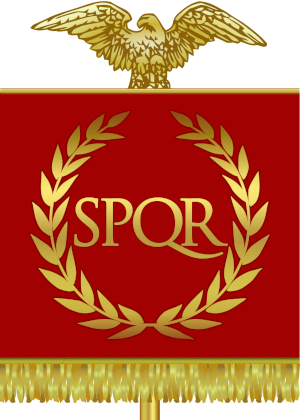Difference between revisions of "Language/Latin/Grammar/Latin-alphabet"
| Line 1: | Line 1: | ||
[[File:rome_27_395.png|thumb]] | [[File:rome_27_395.png|thumb]] | ||
<div style="font-size:300%;"> '''Latin alphabet, also called Roman alphabet'''</div> | |||
== '''English''' == | == '''English''' == | ||
| Line 216: | Line 216: | ||
|} | |} | ||
|} | |} | ||
==Sources== | |||
https://mylanguages.org | |||
Revision as of 16:14, 26 May 2021
English
Latin alphabet, also called Roman alphabet, was borrowed in very early times from a Greek alphabet and in classical period has 23 letters,
of which 3 are rare (k - y - z), which are found in words of Greek origin. Initially it consisted of capital letters only, and the small letters
with which we are familiar did not come into general use until the close of the eighth century A.D.
Latin distinguishes between long vowels (ā, ē, ī, ō, ū) and short vowels (ă, ĕ, ĭ, ŏ, ŭ), which however are not generally noted in the texts.
All the letters are pronounced.
Français
L'alphabet latin a été emprunté très tôt un alphabet grec et à l'époque classique compte 23 lettres, dont 3 rares (k - y - z),
que l'on trouve dans les mots d'origine grecque. Développé à partir de l'alphabet étrusque à un moment donné avant 600
avant notre ère, il est retracé à travers des étrusques, qui ils l'ont empruntés des Grecs. Initialement, il se composait uniquement
de lettres majuscules, et les minuscules avec lesquelles nous sommes familiers, ces lettres n'ayant été introduites qu'à la Renaissance.
Le latin distingue les voyelles longues (ā, ē , ī , ō , ū) et les voyelles brèves (ă, ĕ, ĭ, ŏ, ŭ), qui toutefois ne sont généralement pas notées dans les textes.
Ελληνικά
Το λατινικό αλφάβητο δανείστηκε πολύ νωρίς το ελληνικό αλφάβητο και στην κλασική εποχή έχει 23 γράμματα,
εκ των οποίων τα 3 είναι σπάνια (k - y - z), τα οποία βρίσκονται σε λέξεις ελληνικής προέλευσης.
Αρχικά, αποτελούνταν μόνο από κεφαλαία γράμματα, η δε πεζή γραφή την οποία γνωρίζουμε δημιουργήθηκε στα τέλη του 8ου μ.Χ αι.
Latin alphabet
|
